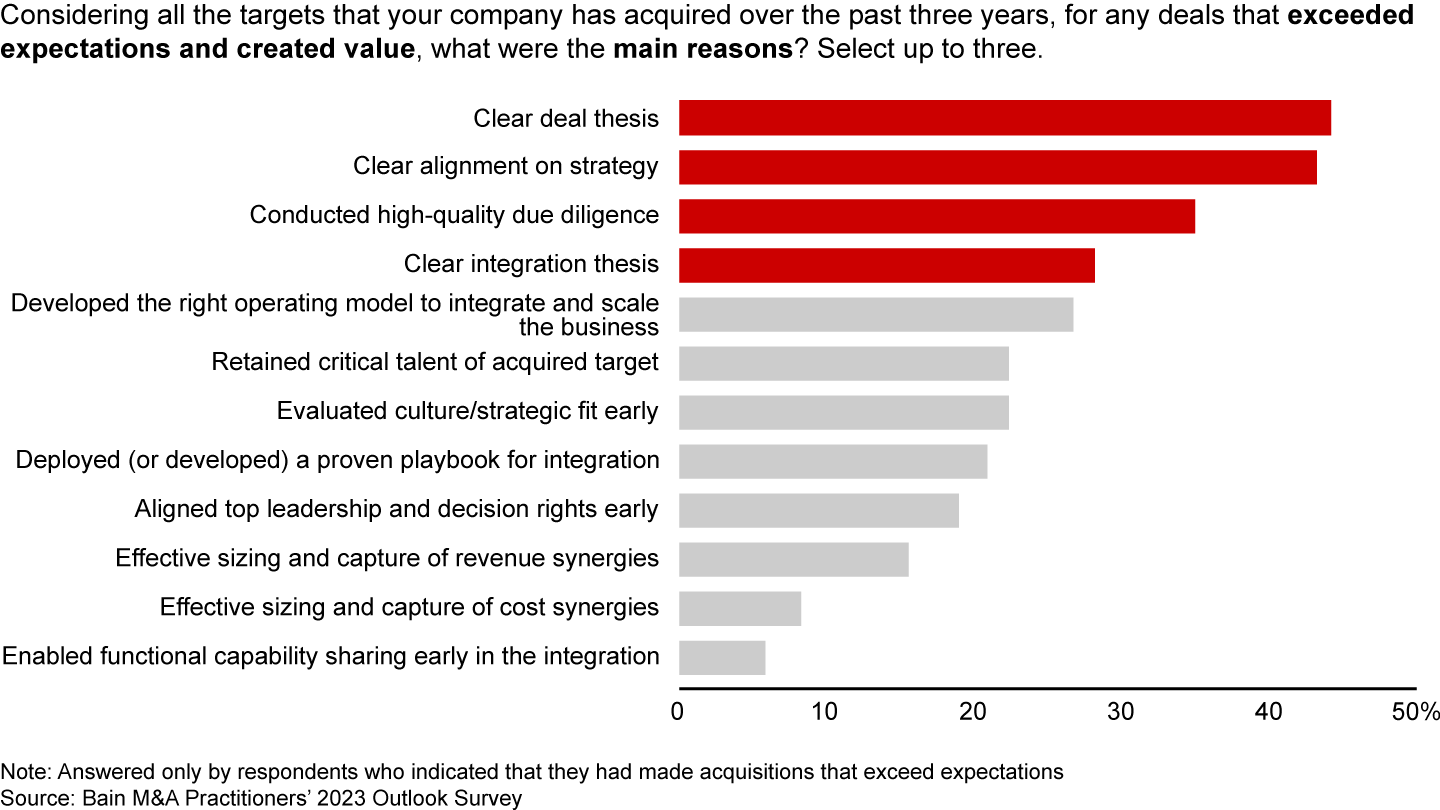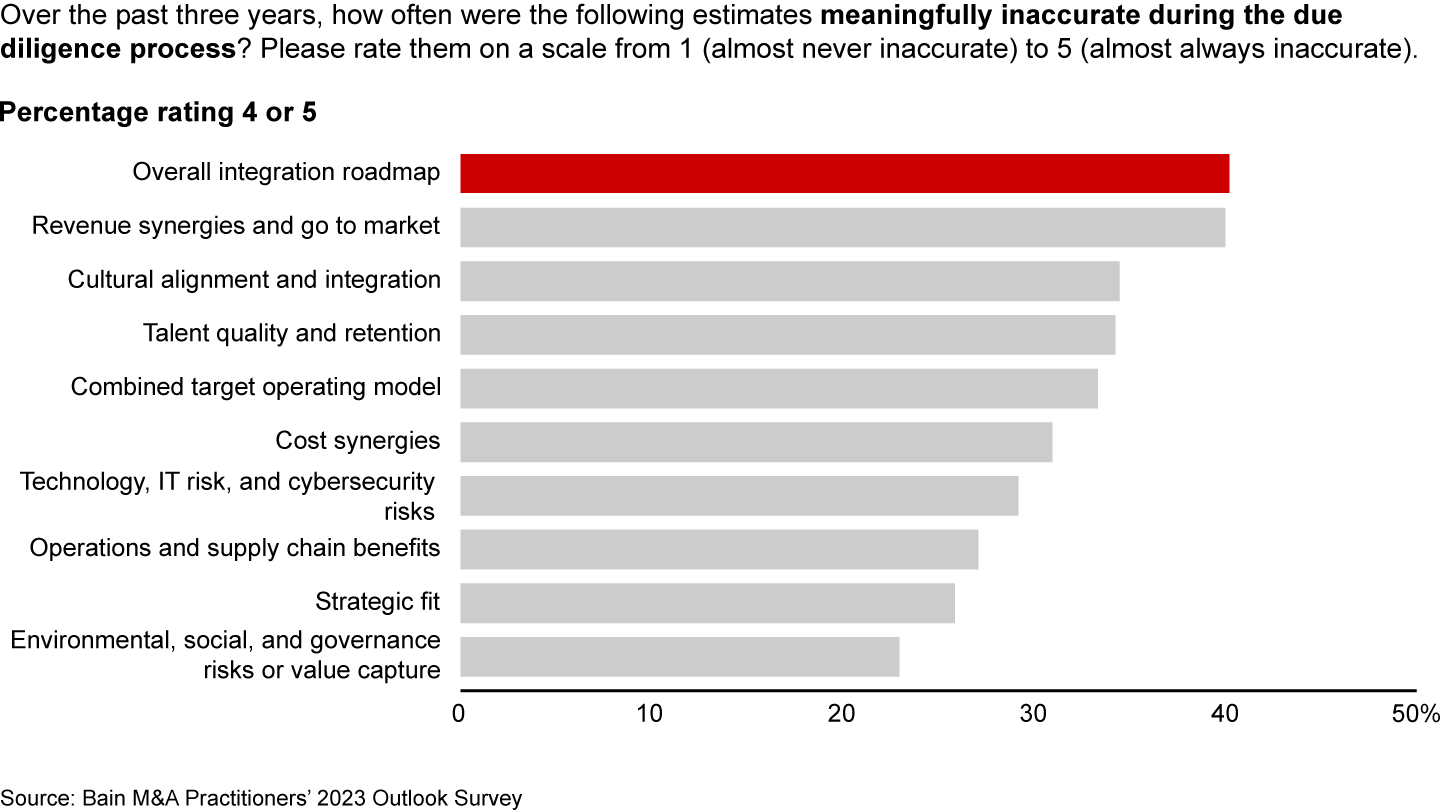M&A Report
 }
}
At a Glance
- To succeed in a volatile market, be armed with proprietary insights from a world-class diligence that goes deeper, with more focus, and in less time than your competitors.
- Initiating diligence before entering the M&A process helps companies avoid being distracted by potential deals that may not be a good fit.
- Winners go beyond high-level benchmarks in diligence, using the full universe of data available to confidently underwrite deal value.
- The most successful acquirers think through integration implications (how long, what cost, who to engage) during, not after, diligence.
This article is part of Bain's 2023 M&A Report.
A manufacturing company relied on its historical experience to estimate cost synergies for a potential acquisition. Facing competition for the deal, it realized it needed to dig deeper for potential sources of value and conducted an outside-in diligence, drawing on additional benchmarks, primary research, and scraping external data sources. The extra effort led the company to uncover more than twice the original estimate of cost synergies and make an offer that allowed it to win the asset. Ultimately, the combined company exceeded the synergies estimated in diligence, making the deal an unqualified success for shareholders.
A technology company’s investment thesis for a potential acquisition relied on the capabilities of the target’s talent base. The acquirer used outside-in mapping of the talent base (more than 10,000 employees) to understand the technical skills and training of the target’s employees. The analysis uncovered that the talent base was missing many of the technical skills that they were looking to acquire. It was a key factor in convincing the company to walk away from the deal.
Winning companies don’t sit on the M&A sidelines, waiting for the market to bottom out.
Multiples are in extremely volatile territory, and if history tells us anything, it’s that winning companies don’t sit on the M&A sidelines, waiting for the market to bottom out; they do deals. But in the race to acquire in a volatile market, it’s more important than ever to have confidence in your deals. The surest way to succeed is to come armed with proprietary insights from a diligence that is faster, deeper, and more focused than your competitors. Better diligence allows you to be bold where others might hesitate.
Market leaders use due diligence in three ways to win (or avoid) deals in today’s environment: They’re proactive; they amplify value through proprietary insights; and they plan for successful integration during diligence, not afterward.

M&A Due Diligence
Make better investment decisions with thorough diligence—leveraging proprietary insights to bid confidently and competitively.
Be proactive
Market leaders will not be reactive, but will initiate diligence before even entering the M&A process. This helps them avoid being distracted by potential deals that may not be a good fit with their strategy. Our M&A Practitioners’ 2023 Outlook Survey found that a clear deal thesis and clear alignment to strategy are the two most important factors leading to successful deals (see Figure 1). Developing that thesis as early as possible allows the acquirers to move quickly when deals are available. The best companies regularly refresh their sector screen and have an evergreen short list of priority targets that are aligned to strategy. They develop an outside-in view of value so that they can move quickly if opportunity arises—or take the offensive and approach the target proactively with conviction, understanding that the industry may be forever changed if a competitor makes the first move.

A leading life sciences company maintains a running list of its top 15 to 20 targets. Using outside-in diligence, the company systematically creates a deal thesis and detailed financial model for each potential deal, updating that view as market conditions change. The company regularly refreshes its short list, looking at more than a hundred targets a year to understand the market landscape and assess its priorities. Similarly, a leading global beverage company uses a data-driven view of its market to stay focused on core targets. This includes understanding competitive positioning and whitespace by geography and maintaining a view of potential synergies, cost to achieve, and speed bumps (regulatory review, capital availability, management bandwidth). The disciplined process ensures that resources are focused on the deals they want to make happen without wasting time on deals that don’t move the ball forward on strategic priorities.
Amplify value through proprietary insights
With increasing interest rates and macroeconomic volatility, acquirers need to sharpen their pencils, ensuring real confidence in the deal thesis and looking past the obvious to identify all possible sources of value. Winners go beyond high-level benchmarks in diligence, using the full universe of data available to them to create proprietary insights that will allow them to confidently underwrite deal value. This includes using advanced analytics tools, scraping external data sources, and applying primary research creatively to address blind spots.
A major consumer goods company recently explored the potential for expanding into the alternative milk space. Lacking visibility into the out-of-home market that represented more than half of the target’s business, it conducted in-person barista interviews and observations at coffee shops in major metro areas. In only five days, the company was able to unlock insights that allowed it to measure a statistically significant share of alternative milk offerings in the coffee shop channel and truly understand the market opportunity.
A medical diagnostic company recently considered walking away from a deal when it couldn’t agree with the target on price. When it decided to conduct additional diligence on pipeline products not yet in the market using extensive expert and customer interviews, it was able to build enough confidence in the potential value to put forward a sweetened offer and complete the acquisition.
Plan for successful integration during diligence, not afterward
In diligence, the focus is often on getting the deal done, with execution an afterthought. We see the most successful acquirers thinking through integration implications, including how long integration will take, what it will cost to achieve, as well as who to engage in the process.
In diligence, execution often is an afterthought to getting the deal done.
The best companies identify the critical issues that underpin the value and build an early integration thesis. They strive to be realistic about costs to achieve, building estimates into the financial model and setting aside the requisite funds solely for the intended integration purposes.
Unfortunately, this area of diligence is one that frequently falls short. In fact, our recent M&A practitioners’ survey found that the integration roadmap was the most underdeveloped aspect of diligence (see Figure 2).

One helpful solution is to engage leaders who have led prior integrations in the deal process, especially if they focused on synergy valuation and timing. Ideally, these companies sign one of them up to lead the integration during diligence and have them weigh in on the deal thesis/financial model along the way.
In a recent diligence, an alcoholic beverage company focused primarily on the market fundamentals, brand health, and synergies. It became apparent during the process, however, that the target had a very different culture and ways of working (see the chapter “How to Avoid the Fault Lines Sending Tremors through Cultural Integration in M&A”). The company quickly focused resources on culture integration and change management to anticipate key friction points and prioritize integration considerations, which then were connected back to synergy values based on what areas of the business would or would not be combined. To integrate cultures, a key decision was made to bring together leadership from different regions into a single headquarters.
Past recessions have been shown to be pivotal times for companies. Our long-term research proves that proactive dealmakers are more likely to emerge from downturns as winners. But in the race to make bold moves, companies need to not only invest in the diligence process but also use the diligence process to outpace the competition.

